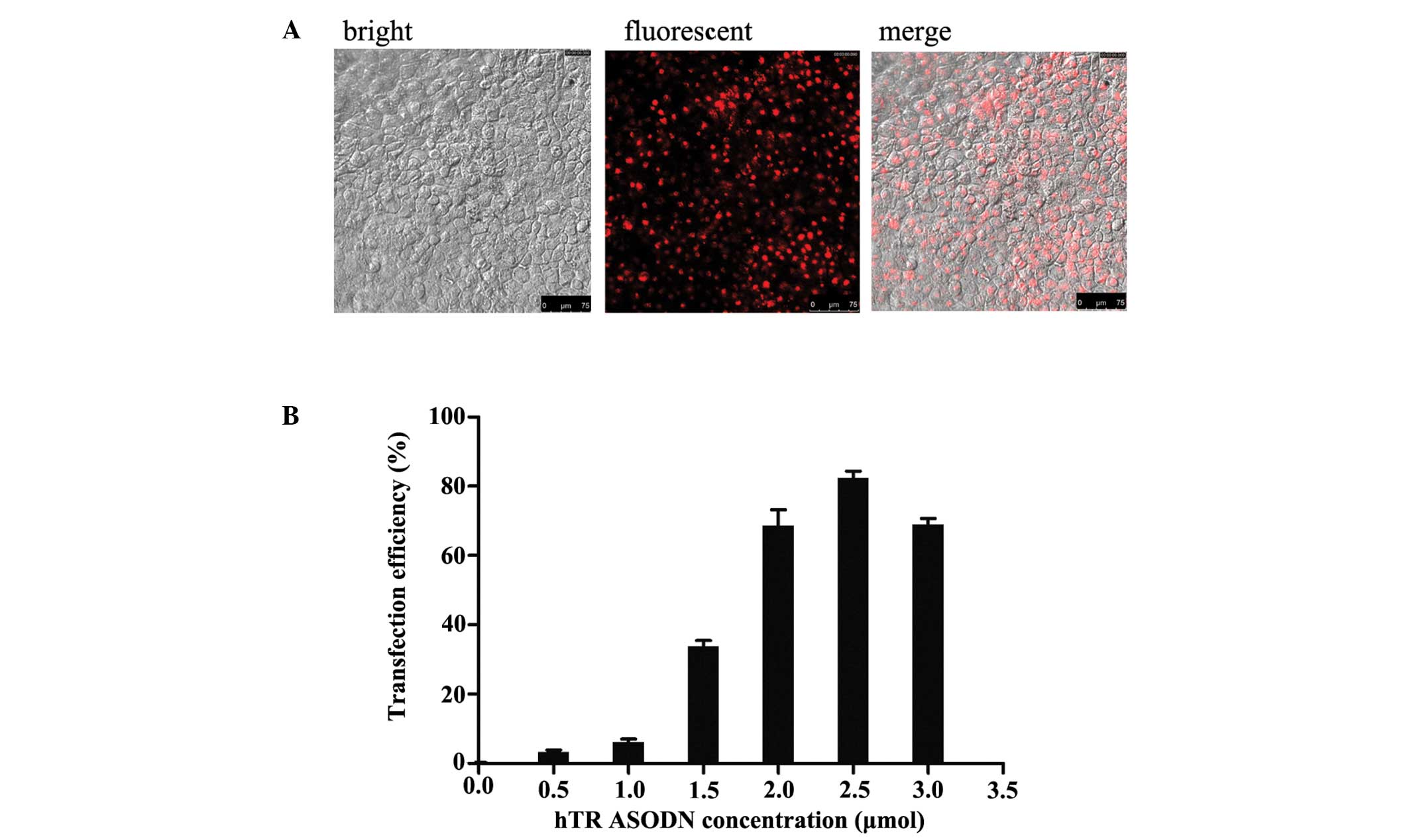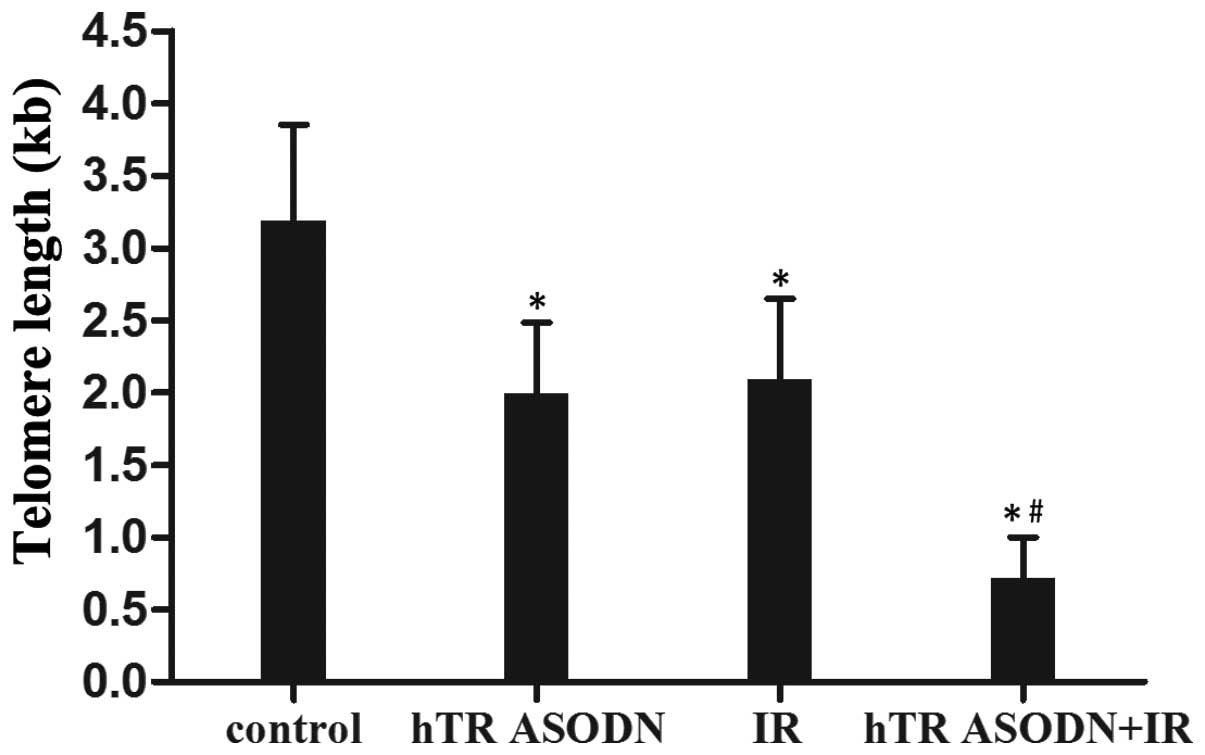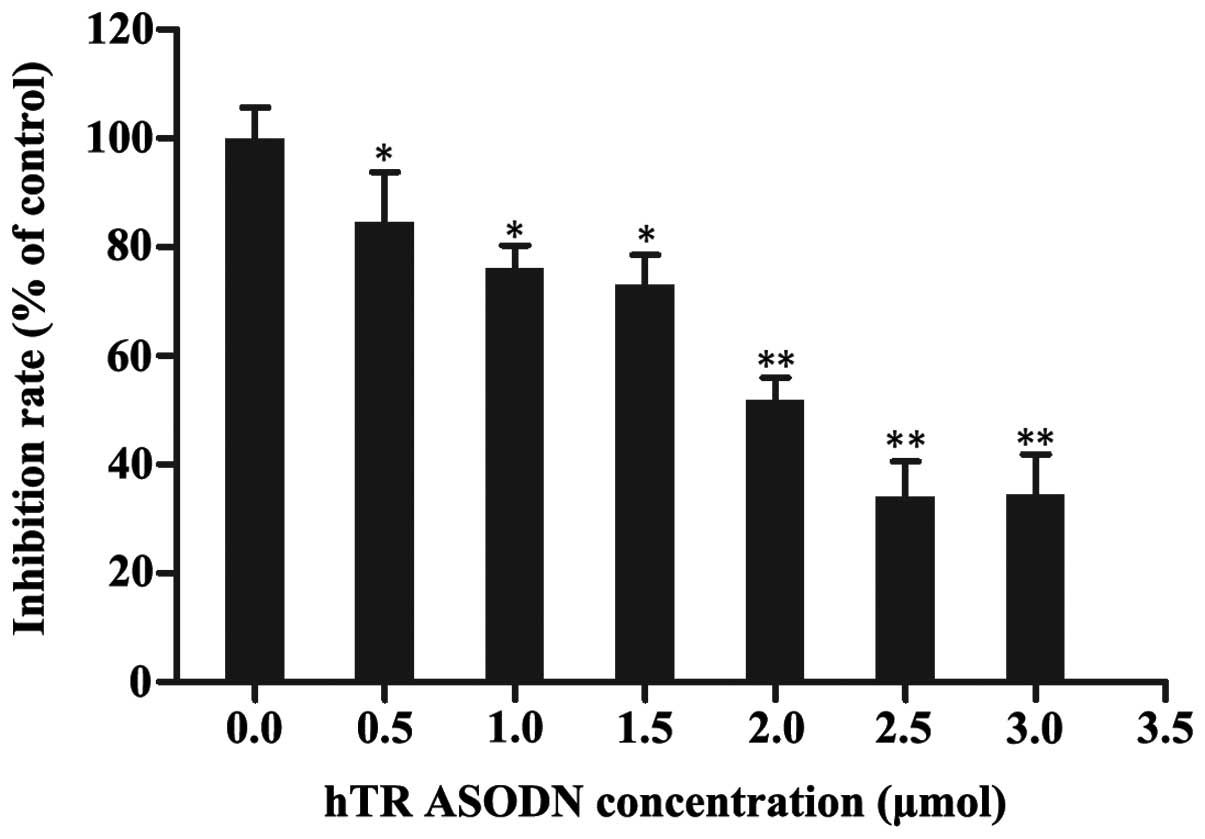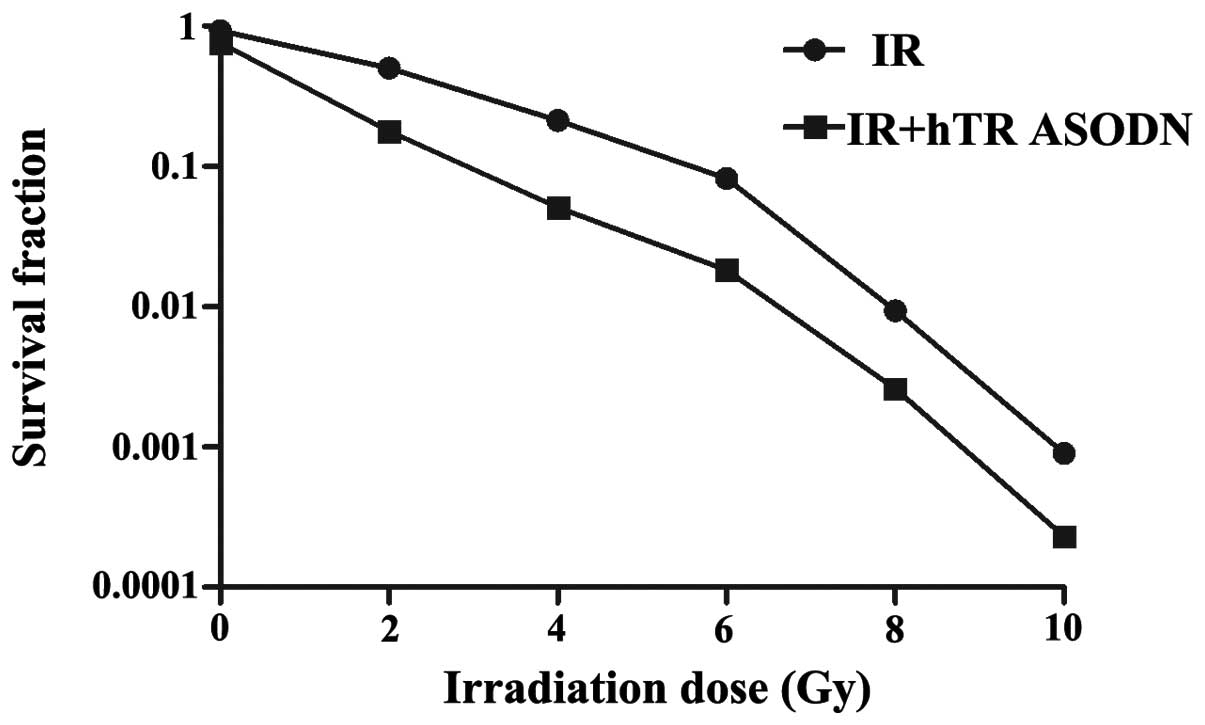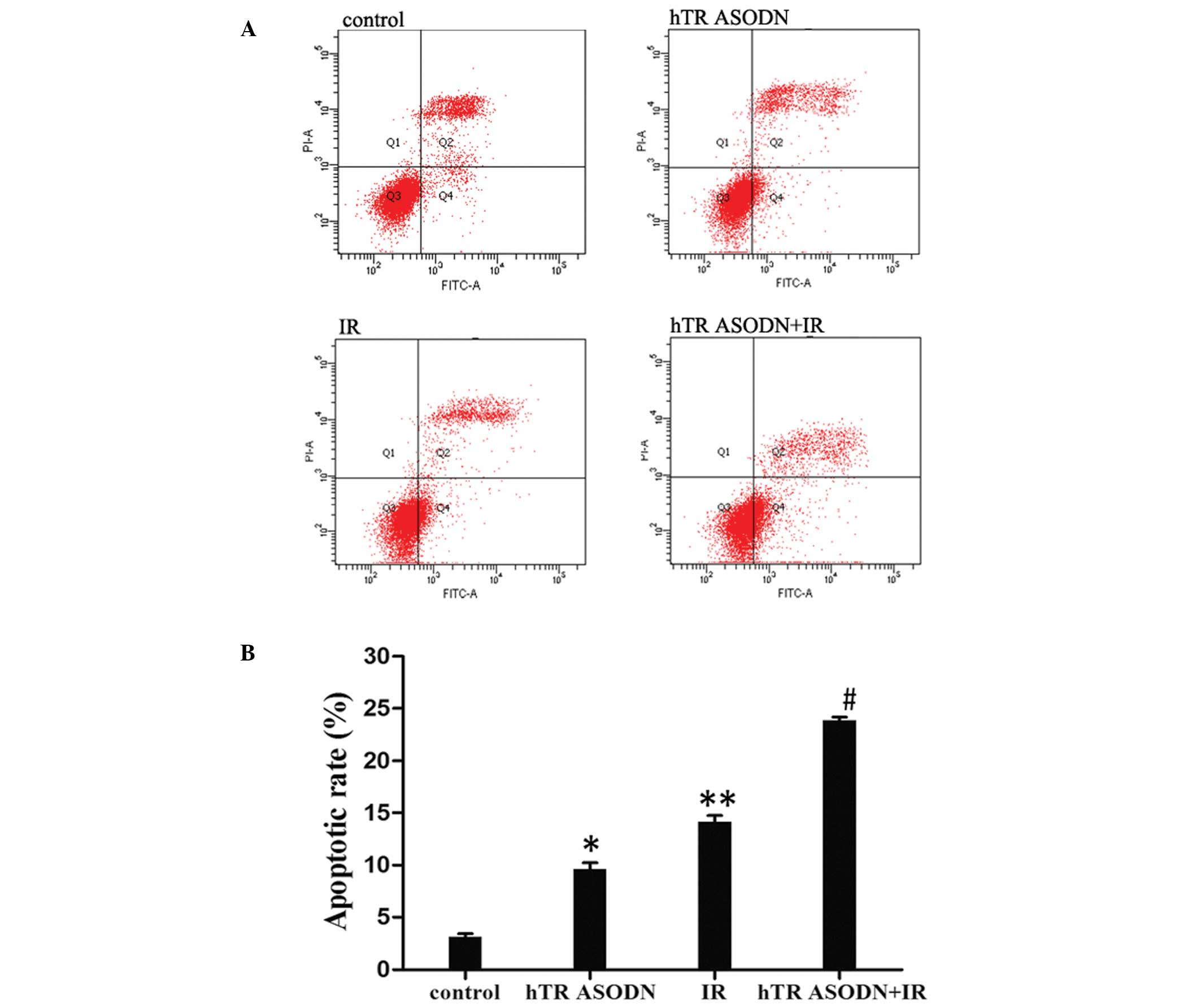Antisense oligonucleotides targeting human telomerase mRNA increases the radiosensitivity of nasopharyngeal carcinoma cells
- Authors:
- Published online on: December 17, 2014 https://doi.org/10.3892/mmr.2014.3105
- Pages: 2825-2830
Abstract
Introduction
Nasopharyngeal carcinoma (NPC) is a squamous-cell carcinoma derived from the epithelial lining of the nasopharynx (1). Its incidence is rare in the United States and Western Europe, however it is common in endemic areas, including South China, North Africa and Alaska (2). South China has the highest incidence rate of NPC, with 25–30 per 100,000 people affected annually, and it is particularly common among people of Cantonese ancestry (3). Since NPC is sensitive to irradiation, radiotherapy is the main therapeutic strategy used to treat NPC. With the improvement of radiotherapy techniques and chemotherapy, the locoregional control of NPC has improved (4), with a cure rate of ~70% (5). However, overall survival remains low. Therefore, the development of multidisciplinary therapeutic strategies that improve locoregional control and eradicate micrometastases is required.
Telomeres are repetitive nucleotides that reside at the ends of human chromosomes, and telomere length is mainly maintained through the activity of telomerase (6). Telomerase is activated in 80–95% of cancers, and is present in very low to undetectable levels in normal cells (7). In normal human cells telomeres are shortened with cell division, however they are continuously elongated in tumor cells. Due to the pivotal role of telomerase in cancer cells, it is considered to be an attractive target for anticancer therapy. Inhibition of telomerase may lead to decreased telomere length, resulting in cell apoptosis in telomerase-positive tumors (8). Potential telomerase inhibitors, including small molecules, antisense oligonucleotides and ribozymes, have previously been developed (9). Preclinical studies have demonstrated that antisense oligonucleotides targeting human telomerase RNA (hTR ASODN) are promising agents for the treatment of various human malignancies (10). In addition, the therapeutic effects of chemotherapy (11,12) and radiation (13) were shown to be enhanced when combined with hTR ASODN. However, the influence of hTR ASODN on the anti-tumor effects of radiation in NPC remain to be elucidated.
The present study aimed to investigate the influence of hTR ASODN on the proliferation and radiosensitivity of NPC cells, and to further explore the underlying mechanisms.
Materials and methods
Cell culture
CNE-2 human undifferentiated NPC cells were cultured in RPMI-1640 medium (Gibco Life Technologies, Carlsbad, CA, USA) supplemented with 10% fetal bovine serum (FBS; Gibco Life Technologies) at 37°C, in a humidified incubator containing 5% CO2. Cells at the logarithmic growth phase were used in the following experiments.
Cell transfection
hTR ASODN was synthesized by Guangzhou Geneseed Biotechnology Co., Ltd. (Guangzhou, China), the sequence of which was: 5′-TAGGGTTAGACAA-3′. The CNE-2 human NPC cells were transiently transfected with hTR ASODN using Lipofectamine® 2000 Transfection reagent (Invitrogen Life Technologies, Carlsbad, CA, USA). The CNE-2 cells (5×106 cells/ml) were transfected with 0.5, 1.0, 1.5, 2.0, 2.5 or 3.0 μmol DNA/106 cells (Lipofectamine®:DNA, 3:1). The transfection efficiency was evaluated by flow cytometry 24 h post-transfection. Cells transfected with Lipofectamine® 2000 only were used as the control group.
Flow-fluorescent in situ hybridization (FISH) assay
The CNE-2 cells were transfected with control or hTR ASODN (2.5 μmol) for 12 h. Irradiation was then conducted at room temperature using an RS 2000 X-ray Biological Irradiator (Rad Source Technologies, Inc., Suwanee, GA, USA), at a dose rate of 1 Gy/min through a 0.2 mm copper filter. The cells were cultured for a further 36 h in RPMI-1640 medium without FBS at 37°C in a humidified incubator containing 5% CO2. A total of 1×106 cells from each sample were washed in 2 ml phosphate-buffered saline (PBS; 135 mM NaCl, 1.3 mM KCl, 3.2 mM Na2HPO4, 0.5 mM KH2PO4) supplemented with 0.1% bovine serum albumin (BSA; Guangzhou Chemistry Reagent Factory, Guangzhou, China). Each sample was divided into two replicate tubes; one pellet was resuspended in 80 μl hybridization buffer (10 mM NaHPO4, pH 7.4; 10 mM NaCl; 20 mM Tris, pH 7.5; 70% formamide), and another in hybridization buffer without fluorescein isothiocyanate (FITC)-labeled telomeric peptide nucleic acid probe, which was used as a negative control. The samples were then denatured for 15 min at 87°C with continuous agitation and hybridized for 2 h in the dark at room temperature. The cells were subsequently washed twice in washing solution (70% deionized formamide, 10 mM Tris, 0.1% BSA and 0.1% Tween® 20 in distilled H2O; pH 7.2). The cells were then centrifuged at 956 × g for 10 min, resuspended in 500 μl of propidium iodide (PI) solution (Kaiji Biotechnology, Nanjing, China), incubated for 2 h at room temperature and stored at 4°C, prior to flow cytometric analysis.
Cell proliferation assay
Cell viability following transfection with hTR ASODN was measured by an MTT assay (Sigma-Aldrich, St. Louis, MO, USA), as described previously (14). Cells in early log phase were trypsinized with 0.25% trypsin (Gibco Life Technologies, Rockville, MD, USA) and seeded in 96-well plates (2×103 cells/well). Following a 36 h incubation in RPMI-1640 medium with 10% fetal bovine serum at 37°C, the medium was refreshed. Cell density was measured using MTT, according to the manufacturer’s instructions. The absorbance of the converted dye was measured at a wavelength of 450 nm using a plate reader (Multiskan MK3; Thermo Labsystems, Waltham, MA, USA), and the absorbance was considered directly proportional to cell viability. This experiment was repeated ≥three times.
Colony formation assay
The clonogenic potential of the cells treated with hTR ASODN and/or ionizing radiation was assessed using a colony formation assay. Briefly, the cells were transfected with the control or hTR ASODN (2.5 μmol) for 12 h. Cells were trypsinized and plated in six-well plates at 200, 500, 3,000, 5,000, and 10,000 cells per well and cultured overnight to allow for cell attachment. Irradiation was then performed at room temperature using an RS 2000 X-ray Biological Irradiator, at doses corresponding to 0, 2, 4, 6, and 8 Gy, through a 0.2 mm copper filter. The plates were then incubated for 10 days at 37°C, and the growth medium was replaced every three days. The plates were then stained with 0.1% crystal violet (Sigma-Aldrich), and colonies containing ≥50 cells were counted under an inverted microscope (IMT-2; Olympus Corp., Tokyo, Japan). The cell surviving fraction was determined relative to the survival of non-irradiated cells transfected with Lipofectamine® 2000 only.
Apoptosis assay
The percentage of apoptotic cells was determined by flow cytometry using the Annexin V-FITC Apoptosis Detection kit (Kaiji Biotechnology Co., Nanjing, China), as described previously (14). Briefly, the cells were collected, washed three times with PBS and fixed with 1 ml ethanol (70%) for 2 h at 4°C. The cells were washed again with PBS, and the supernatants were removed following centrifugation at 956 × g for 10 min. The cells were then treated with 500 μl Annexin binding buffer, 5 μl Annexin V-FITC and 5 μl PI, and incubated at room temperature in the dark for 15 min. The rate of cell apoptosis was determined by flow cytometry (BD Biosciences, Franklin Lakes, NJ, USA).
Western blot analysis
The CNE-2 cells were transfected with the control or hTR ASODN (2.5 μmol) and/or radiation at a total dose of 6 Gy 12 h post-transfection. At 36 h post-transfection, whole cell lysates were collected and protein concentrations were determined using the Bio-Rad Protein Assay kit (Bio-Rad Laboratories, Inc., Hercules, CA, USA). Whole cell extracts were separated using 14% SDS-PAGE and transferred onto PVDF membranes (Bio-Rad Laboratories, Inc.). Following incubation with 5% nonfat milk in TBST (10 mM Tris, pH 8.0, 150 mM NaCl, 0.5% Tween 20) for 1 h, the membranes were washed once with TBST and incubated with a polyclonal rabbit anti-Caspase 9 antibody (9502; 1:1,000; Cell signaling technology, Inc., Danvers, MA, USA) at 4°C overnight. Membranes were then washed three times with TBST for 10 min and incubated with horseradish peroxidase-conjugated anti-rabbit antibodies (1:2,000; A0208; Beyotime Institute of Biotechnology, Shanghai, China) at 4°C for 2 h. Blots were washed with TBST three times and visualized using Super Enhanced Chemiluminescence Plus Detection Reagent (Applygen Technologies, Inc., Beijing, China) according manufacturer’s instructions. The same membrane was stripped and re-blotted with an anti-β-actin antibody (Sigma-Aldrich) for normalization.
Statistical analysis
Statistical analyses were performed using SPSS version 17.0 software (SPSS, Inc., Chicago, IL, USA). The data are expressed as the mean ± standard deviation and statistical significance was analyzed by analysis of variance. P<0.05 was considered to indicate a statistically significant difference.
Results
Transient transfection of hTR ASODN into CNE-2 cells
To evaluate the efficacy of hTR ASODN transfection by Lipofectamine® 2000, transfections using various concentrations of DNA were performed. The CNE-2 cells (5×106 cells/ml) were transfected with 0.5, 1.0, 1.5, 2.0, 2.5 or 3.0 μmol hTR ASODN (Lipofectamine®:DNA, 3:1). The transfection efficiency of the various concentrations of DNA were 2.6±0.43, 5.2±0.79, 35.4±0.51, 69±0.57, 82.6±0.42 and 69.2±0.49% when transfected with 0.5, 1.0, 1.5, 2.0, 2.5 and 3.0 μmol DNA, respectively. The best transfection efficiency was observed with a DNA concentration of 2.5 μmol DNA/5×106 cells, 48 h post-transfection (Fig. 1).
Transfection with hTR ASODN decreases telomere length in CNE-2 cells
Flow-FISH techniques were used to determine the effects of hTR ASODN and radiation on telomere length in CNE-2 cells. The telomere length of the untreated control cells and those treated with irradiation, hTR ASODN and hTR ASODN combined with irradiation were 3193±659 bases, 2093±555 bases, 1993±491 bases and 717±284 bases, respectively. In addition, combined treatment with hTR ASODN and irradiation led to an increased rate of apoptosis of the CNE-2 cells (Fig. 2).
hTR ASODN inhibits the growth of CNE-2 cells
To determine the inhibitory effects of hTR ASODN on human NPC cells, the growth of CNE-2 cells was measured using an MTT assay. The CNE-2 cells were transfected with 0.5, 1.0, 1.5, 2.0, 2.5 or 3.0 μmol DNA/5×106 cells (Lipofectamine®:DNA, 3:1). The growth of CNE-2 cells was markedly inhibited 48 h post-transfection, as compared with the control cells. The growth inhibitory rate of the cells transfected with hTR ASODN (2.5 μmol) was 73±0.69% (Fig. 3). These results suggest that hTR ASODN exhibits potential cytotoxic activity against human NPC cells.
hTR ASODN enhances the cytotoxic effects of X-ray irradiation on CNE-2 cells
To determine the effects of hTR ASODN on radiosensitization of CNE-2 cells, a colony forming assay was performed on the cells either treated with irradiation, or transfected with hTR ASODN (2.5 μmol) followed by irradiation. The cells transfected with hTR ASODN followed by radiation exposure exhibited a greater inhibition of colony formation, as compared with the control cells (Fig. 4, P<0.01). Further analysis of clonogenic survival indicated that the sensitization enhancement ratio (SER) was 1.479. These results suggest that hTR ASODN may be capable of sensitizing NPC cells to the cytotoxic effects of radiation treatment.
hTR ASODN enhances the pro-apoptotic effects of X-ray irradiation in CNE-2 cells
To investigate the underlying mechanisms of the inhibition of colony survival following transfection of the CNE-2 cells with hTR ASODN (2.5 μmol) and radiation (6 Gy), the cells were analyzed by flow cytometry. The rate of apoptosis was significantly increased by transfection with hTR ASODN or irradiation alone, as compared with the control group. Combined treatment of hTR ASODN with irradiation significantly increased the rate of cell apoptosis, as compared with either hTR ASODN or irradiation treatment alone (Fig. 5A). The apoptotic rate of the untreated controls and the cells treated with irradiation, hTR ASODN and hTR ASODN combined with irradiation were 3.2±0.6, 9±2.2, 14.2±2.1 and 23.8±1.87%, respectively. Combined treatment of hTR ASODN with irradiation led to increased cell apoptosis of CNE-2 cells (Fig. 5B, P<0.05). In addition, the results of a western blot analysis suggested that combined treatment of hTR ASODN with irradiation led to increased protein expression levels of cleaved caspase 9 in the CNE-2 cells, thus indicating an increased rate of cell apoptosis (Fig. 6).
Discussion
The present study explored the effects of hTR ASODN on the CNE-2 NPC cell line. Transfection with hTR ASODN significantly reduced the telomere length, inhibited the proliferation of NPC cells and enhanced the anti-tumor efficacy of radiation by inducing cell apoptosis. This is the first study, to the best of our knowledge, to determine the effects of hTR ASODN in combination with radiation on NPC.
The results of the present study demonstrated that hTR ASODN was efficiently transfected into CNE-2 cells using Lipofectamine® 2000. The transfection efficiency reached 82.6% when the cells were transfected with 2.5 μmol DNA/5×106 cells. Furthermore, transfection with hTR ASODN significantly reduced the growth of the CNE-2 cells. Human telomerase consists of the hTR and the human reverse transcriptase catalytic subunit (hTERT) (15). Since telomerase activity is present in ~90% of human cancer cells, but not in the majority of normal human somatic cells, telomerase inhibition is considered to be a potent molecular target in cancer therapeutics (16). A previous study detected frequently increased levels of telomerase activity in NPC, as compared with normal nasopharyngeal tissue (17). Furthermore, previous studies have observed tumor inhibitory effects by targeting telomerase. Wang et al (18) demonstrated that short hairpin RNA targeting hTERT inhibited cell viability in NPC cells. In addition, ASODN targeting telomerase were also shown to inhibit the growth of NPC cells (19). Therefore, inhibition of telomerase activity by hTR ASODN may be a potential therapeutic strategy in NPC.
Since radiotherapy is currently the main treatment for NPC, the present study investigated the combined effects of radiation and hTR ASODN on CNE-2 cells. The results demonstrated that transfection with hTR ASODN significantly enhanced the radiosensitivity of CNE-2 cells, with a SER of 1.479. These results were concordant with the findings of previous studies. The shortening of telomeres induced by GRN163L, an oligonucleotide targeting the RNA component of telomerase, was previously shown to significantly enhance the effects of radiation in breast cancer cells (13). Treatment with GRN163L in combination with radiation and temozolomide also exhibited a marked effect on cell survival, and activated the DNA damage response pathway (20). Notably, a previous study demonstrated that high doses of radiation (2, 4 and 8 Gy) resulted in decreased telomerase activity (down to 30% of untreated controls), which subsequently resulted in increased cell death, thus suggesting that inhibition of telomerase activity by high doses of radiation may have a role in radiation-induced cell death (21). The present study determined the rate of apoptosis of the untreated cells and those treated with irradiation, hTR ASODN and hTR ASODN combined with irradiation, and the rates were 3.2±0.6, 9±2.2, 14.2±2.1, 23.8±1.87%, respectively. These results suggest that transfection with hTR ASODN combined with irradiation significantly increased the rate of cell apoptosis, as compared with either hTR ASODN or irradiation treatment alone. In addition, the results of a western blot analysis demonstrated that transfection with hTR ASODN combined with irradiation significantly increased the protein expression levels of cleaved caspase 9. Therefore, it may be hypothesized that hTR ASODN combined with radiation may induce cell apoptosis by synergistically reducing telomerase activity.
In conclusion, the present study demonstrated that hTR ASODN could inhibit the proliferation of NPC cells and enhance the anti-tumor effects of radiation by inducing cell apoptosis. These data indicate that hTR ASODN may be a potential adjuvant agent for the treatment of NPC in combination with radiation therapy, and this finding is of translational importance.
Acknowledgements
The present study was supported by the National Nature Science Foundation of China (grant no. 81201736), the Science and Technology Planning Project of Guangdong Province, China (grant nos. KZ 0710, KZ 1021 and 2007B031516001) and the Science and Technology Innovation Project of Guangdong Medical College, China (grant no. TD1124).
References
|
Wei WI and Sham JS: Nasopharyngeal carcinoma. Lancet. 365:2041–2054. 2005. View Article : Google Scholar : PubMed/NCBI | |
|
Yu MC and Yuan JM: Epidemiology of nasopharyngeal carcinoma. Semin Cancer Biol. 12:421–429. 2002. View Article : Google Scholar : PubMed/NCBI | |
|
Feng BJ, Huang W, Shugart YY, et al: Genome-wide scan for familial nasopharyngeal carcinoma reveals evidence of linkage to chromosome 4. Nat Genet. 31:395–399. 2002.PubMed/NCBI | |
|
Lee N, Xia P, Quivey JM, et al: Intensity-modulated radiotherapy in the treatment of nasopharyngeal carcinoma: an update of the UCSF experience. Int J Radiat Oncol Biol Phys. 53:12–22. 2002. View Article : Google Scholar : PubMed/NCBI | |
|
Yang GD, Huang TJ, Peng LX, et al: Epstein-Barr Virus_Encoded LMP1 upregulates microRNA-21 to promote the resistance of nasopharyngeal carcinoma cells to cisplatin-induced Apoptosis by suppressing PDCD4 and Fas-L. PLoS One. 8:e783552013. View Article : Google Scholar : PubMed/NCBI | |
|
Ruden M and Puri N: Novel anticancer therapeutics targeting telomerase. Cancer Treat Rev. 39:444–456. 2013. View Article : Google Scholar | |
|
Ouellette MM, Wright WE and Shay JW: Targeting telomerase-expressing cancer cells. J Cell Mol Med. 15:1433–1442. 2011. View Article : Google Scholar : PubMed/NCBI | |
|
Ruden M and Puri N: Novel anticancer therapeutics targeting telomerase. Cancer Treat Rev. 39:444–456. 2013. View Article : Google Scholar | |
|
Röth A, Harley CB and Baerlocher GM: Imetelstat (GRN163L) - telomerase-based cancer therapy. Recent Results Cancer Res. 184:221–234. 2010. View Article : Google Scholar | |
|
Shay JW and Keith WN: Targeting telomerase for cancer therapeutics. Br J Cancer. 98:677–683. 2008. View Article : Google Scholar : PubMed/NCBI | |
|
Xu Q, Zhang Z, Zhang P and Chen W: Antisense oligonucleotides and all-trans retinoic acid have a synergistic anti-tumor effect on oral squamous cell carcinoma. BMC Cancer. 8:1592008. View Article : Google Scholar : PubMed/NCBI | |
|
Goldblatt EM, Gentry ER, Fox MJ, Gryaznov SM, Shen C and Herbert BS: The telomerase template antagonist GRN163L alters MDA-MB-231 breast cancer cell morphology, inhibits growth, and augments the effects of paclitaxel. Mol Cancer Ther. 8:2027–2035. 2009. View Article : Google Scholar : PubMed/NCBI | |
|
Gomez-Millan J, Goldblatt EM, Gryaznov SM, Mendonca MS and Herbert BS: Specific telomere dysfunction induced by GRN163L increases radiation sensitivity in breast cancer cells. Int J Radiat Oncol Biol Phys. 67:897–905. 2007. View Article : Google Scholar | |
|
Xu Z, Fang S, Zuo Y, et al: Combination of pigment epithelium-derived factor with radiotherapy enhances the antitumor effects on nasopharyngeal carcinoma by downregulating vascular endothelial growth factor expression and angiogenesis. Cancer Sci. 102:1789–1798. 2011. View Article : Google Scholar : PubMed/NCBI | |
|
Blackburn EH: Switching and signaling at the telomere. Cell. 106:661–673. 2001. View Article : Google Scholar : PubMed/NCBI | |
|
Kyo S and Inoue M: Complex regulatory mechanisms of telomerase activity in normal and cancer cells: how can we apply them for cancer therapy? Oncogene. 21:688–697. 2002. View Article : Google Scholar : PubMed/NCBI | |
|
Zhang Y, Zhang H, Zhai Y, et al: A functional tandem-repeats polymorphism in the downstream of TERT is associated with the risk of nasopharyngeal carcinoma in Chinese population. BMC Med. 9:1062011. View Article : Google Scholar : PubMed/NCBI | |
|
Wang Y, Duan HG, Chen SM, Xiao BK, Cheng J and Tao ZZ: Effect of RNA interference targeting human telomerase reverse transcriptase on telomerase and its related protein expression in nasopharyngeal carcinoma cells. J Laryngol Otol. 121:476–482. 2007. View Article : Google Scholar | |
|
Zhang SZ, Huang PC, Xu Y, Chen J and Cai KR: Effects of telomerase sense and antisense oligodeoxynucleotides on growth and differentiation of nasopharyngeal carcinoma cells. Ai Zheng. 21:493–497. 2002.(In Chinese). PubMed/NCBI | |
|
Marian CO, Cho SK, McEllin BM, et al: The telomerase antagonist, imetelstat, efficiently targets glioblastoma tumor-initiating cells leading to decreased proliferation and tumor growth. Clin Cancer Res. 16:154–163. 2010. View Article : Google Scholar : PubMed/NCBI | |
|
Wang X, Liu Y, Chow LS, et al: Regulation of telomerase activity by gamma-radiation in nasopharyngeal carcinoma cells. Anticancer Res. 20:433–437. 2000.PubMed/NCBI |



